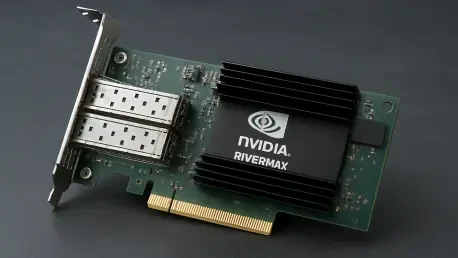In the high-stakes arena of financial services, where algorithmic trading and real-time market data distribution dominate, even a microsecond of delay or a single lost packet can translate into millions of dollars in losses, and the pressure to execute trades at lightning speed while processing vast streams of data without error has never been greater, especially as market volatility and competition intensify. NVIDIA Rivermax, an innovative software library, paired with NEIO Systems Ltd.’s FastSockets middleware, emerges as a transformative solution to these challenges. By harnessing GPU-accelerated technology and advanced networking capabilities, this powerful duo ensures ultra-low-latency data transfers with zero packet loss, redefining performance standards for the finance industry. Beyond the trading floor, sectors like cloud gaming and media production also grapple with similar demands for speed and reliability, where traditional networking systems falter under the strain of modern high-speed networks like 10, 25, or even 100 GbE. This technology offers a promising glimpse into how cutting-edge tools can address the critical needs of time-sensitive applications across diverse fields, setting the stage for a deeper exploration of its impact and potential.
Addressing the Urgency of Speed in Financial Systems
The financial sector operates in a realm where time is quite literally money, especially in the context of algorithmic trading and high-frequency market data analysis. A mere fraction of a second in delay can disrupt trade execution, leading to missed opportunities or inaccurate decisions that cost firms dearly. NVIDIA Rivermax steps into this high-pressure environment with a focus on deterministic networking, ensuring that data arrives precisely when expected, without fail. This level of reliability is not just an advantage but a fundamental requirement for maintaining a competitive edge in markets where split-second timing can determine success or failure. The ability to handle massive data streams without dropping a single packet becomes a game-changer, particularly when every piece of information is critical to shaping trading strategies.
Beyond the immediate impact on trades, the broader implications of latency and data loss resonate across financial operations, from risk management to regulatory compliance. When systems falter, the ripple effects can undermine confidence in automated processes and expose firms to unforeseen vulnerabilities. Rivermax’s approach counters these risks by prioritizing both speed and accuracy, offering a robust framework that traditional networking stacks struggle to match. As network speeds continue to scale upward, the gap between outdated infrastructure and modern demands widens, making solutions like this not just beneficial but essential for staying ahead in a relentlessly fast-paced industry.
Unleashing Performance with Advanced Software Solutions
At the heart of this networking revolution lies NVIDIA Rivermax, a high-performance software library meticulously engineered for data streaming in demanding environments. By integrating NVIDIA GPUs with cutting-edge network interface cards such as ConnectX adapters, it achieves remarkable throughput while slashing latency to near-imperceptible levels. A standout feature is its kernel bypass capability, which eliminates the usual operating system overhead by facilitating direct data transfers between user-space memory and the network card. This efficiency translates into significantly reduced CPU usage, freeing up system resources for other critical tasks. For financial applications, where every performance gain directly impacts trading outcomes, such innovations provide a tangible advantage in processing market data at unprecedented speeds.
Complementing this is a suite of technical advancements, including zero-copy architecture that minimizes unnecessary data duplication and hardware-based packet pacing for precise timing control. These elements ensure seamless data movement without the bottlenecks that plague conventional systems, maintaining both speed and reliability under intense workloads. In the finance sector, where precision is as vital as velocity, Rivermax’s ability to deliver consistent performance under pressure stands out. It’s a tailored solution for scenarios where even minor inefficiencies can cascade into major setbacks, proving that cutting-edge technology can redefine the boundaries of what’s achievable in real-time data handling.
Elevating Socket Efficiency with Complementary Middleware
Building on the foundation laid by Rivermax, NEIO FastSockets emerges as a specialized middleware that enhances socket-based communication for high-speed networks. Designed to optimize both UDP and TCP protocols at speeds of 25 GbE and beyond, FastSockets ensures dropless delivery, meaning no data is lost even under the most strenuous conditions. By sidestepping traditional socket limitations through direct data delivery from the network card to the application, it dramatically cuts latency and boosts bandwidth efficiency. For financial trading platforms, this translates into market data arriving faster and more reliably, empowering traders to act on the most current information without fear of gaps or delays that could skew their decisions.
The significance of this middleware extends to its adaptability across various high-stakes scenarios within finance, from order execution to real-time analytics. Traditional communication methods often buckle under high packet rates, introducing delays that can compromise critical operations. FastSockets counters this by maintaining performance integrity, ensuring that data streams remain uninterrupted regardless of volume or speed. This reliability offers a competitive edge in environments where timing is everything, allowing firms to capitalize on fleeting market opportunities with confidence. As a complement to Rivermax, it underscores the power of integrated solutions in addressing the nuanced demands of modern networking challenges in the financial world.
Tackling Protocol Limitations for Seamless Data Flow
Many financial applications lean on the User Datagram Protocol (UDP) for its speed in data transfer, particularly in scenarios like market data feeds where immediacy is paramount. However, UDP’s connectionless nature means it lacks inherent mechanisms for ensuring reliable delivery, leaving room for packet loss that can disrupt critical operations. In trading, such losses can trigger retransmissions or create data gaps, both of which introduce unacceptable delays in a field where microseconds matter. FastSockets, built on Rivermax’s robust architecture, addresses this vulnerability by guaranteeing dropless reception, ensuring every packet reaches its destination intact and on schedule. This reliability is a cornerstone for maintaining the integrity of time-sensitive financial processes.
The broader challenge of balancing speed with dependability in UDP-based systems is a persistent hurdle across latency-sensitive domains, and the stakes are especially high in finance. A missed data point can alter the outcome of a trade or skew analytical models, leading to costly missteps. By focusing on seamless data delivery without sacrificing velocity, FastSockets provides a vital safety net, ensuring that performance doesn’t come at the expense of accuracy. This dual focus on efficiency and trustworthiness makes it an indispensable tool for firms navigating the complexities of real-time data streams, offering a way to mitigate risks while maximizing responsiveness in dynamic market conditions.
Shaping the Future of High-Speed Financial Networking
Looking ahead, the integration of technologies like GPUDirect with Rivermax points to even greater strides in financial networking performance. By enabling direct memory access between network cards and GPUs, this approach bypasses the CPU entirely, further reducing latency and allowing high-frequency market data to flow straight into GPU memory for processing. This capability is particularly transformative for algorithmic trading, where rapid analysis of incoming data can uncover market patterns or anomalies in real time. The potential to execute advanced AI models—such as anomaly detection or predictive analytics—directly on this data stream opens new avenues for strategic decision-making, enhancing both speed and precision in volatile trading environments.
Additionally, the convergence of such networking solutions with AI-driven tools signals a shift toward smarter, more adaptive financial systems. As data volumes grow and network demands escalate, the ability to process and act on information instantaneously becomes a defining factor in market success. Rivermax and FastSockets lay the groundwork for this evolution, providing the infrastructure needed to support next-generation applications. For financial firms, adopting these technologies now positions them to not only meet current challenges but also anticipate future needs, ensuring they remain agile in an ever-accelerating landscape. The promise of near-instantaneous responses to market shifts redefines what’s possible, setting a new benchmark for the industry.
Reflecting on a Transformative Leap Forward
The journey through the capabilities of NVIDIA Rivermax and NEIO FastSockets reveals a pivotal moment in the evolution of low-latency networking for financial services. Their combined strength in delivering ultra-fast, reliable data transfers tackles the pressing challenges of algorithmic trading and market data distribution head-on, ensuring that delays and packet losses become relics of a bygone era. Benchmarking validates their superiority, showcasing unmatched throughput and minimal latency that outstrip traditional systems. For industries beyond finance, their impact echoes similarly, proving versatility in addressing time-sensitive demands. Moving forward, the challenge lies in scaling these solutions to meet growing data demands and integrating them with emerging AI tools to enhance real-time decision-making. Financial firms that embrace this technology stand poised to leverage its benefits, adapting swiftly to market dynamics with a robust foundation for innovation. The next step involves exploring broader applications and refining these tools to anticipate evolving network complexities, ensuring sustained competitiveness in a data-driven world.









